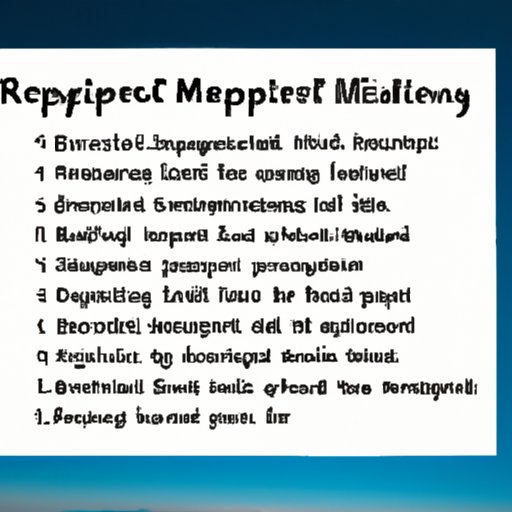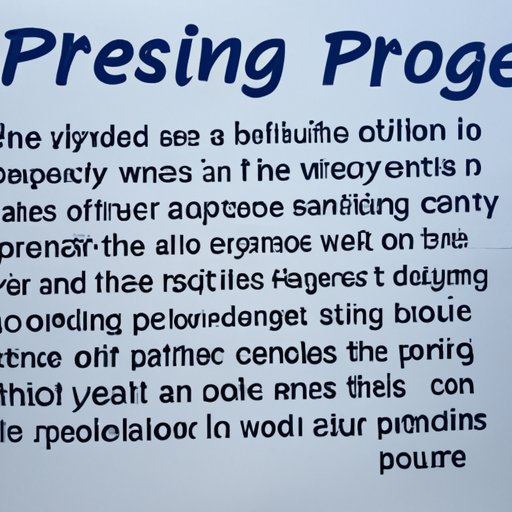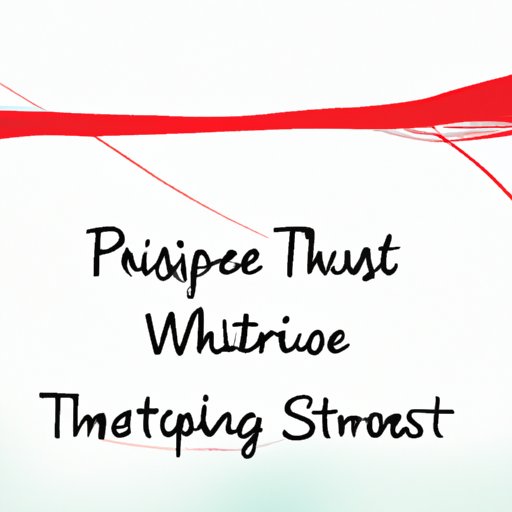Introduction
Perspective in writing is an important concept that can greatly affect the overall tone and feel of a narrative. It involves the viewpoint from which the story is told, and can be used to create a unique style and voice. By exploring the different types of perspective available and understanding how to use them to your advantage, you can craft compelling stories that draw readers in and leave a lasting impression.

Exploring the Different Types of Perspective in Writing
The most common types of perspective in writing are first person, second person, third person, and omniscient. Each type has its own distinct characteristics and can be used to create a specific tone and feel. Let’s take a look at each of these in more detail.
First Person Narrative
First person perspective is when the narrator is one of the characters in the story and refers to themselves as “I” or “we”. This is a popular choice among authors as it allows them to explore their protagonist’s thoughts, feelings, and motivations in greater depth. It can also create a sense of intimacy between the reader and the character, as the reader is able to experience the story through the narrator’s eyes.
Second Person Narrative
Second person perspective is when the narrator speaks directly to the reader, referring to them as “you”. This type of writing can be used to create a direct connection between the reader and the story, as it encourages the reader to imagine themselves as part of the narrative. However, it can be difficult to sustain over an entire novel, so it is usually used sparingly.
Third Person Narrative
Third person perspective is when the narrator is not a character in the story and refers to characters as “he”, “she”, or “they”. This is the most commonly used type of perspective, as it allows the author to provide an objective view of the story while still providing insight into the characters’ thoughts and feelings. It can also be used to create suspense and mystery, as the reader does not know what the characters are thinking.
Omniscient Narrative
Omniscient perspective is when the narrator has access to all characters’ thoughts and feelings. This type of writing can be used to tell complex stories with multiple characters, as it allows the author to explore the inner workings of each character without having to rely on a single point of view. It can also be used to provide an overarching commentary on the events of the story.
A Guide to Understanding and Implementing Perspective in Your Work
Now that we have explored the different types of perspective in writing, let’s look at how you can use them to your advantage. Here are some tips for understanding and implementing perspective in your work.
Identify Your Desired Tone and Feel
Before you begin writing, it’s important to consider the tone and feel you want to create for your story. Do you want to evoke a sense of mystery? Create intimate connections between characters? Establish a clear sense of right and wrong? Once you’ve identified your desired tone and feel, you can choose the right perspective to help achieve it.
Choose the Right Perspective
Once you’ve identified your desired tone and feel, it’s time to choose the right perspective to bring it to life. Consider the advantages and disadvantages of each type of perspective and decide which will best suit your story. For example, if you want to create a sense of mystery, a third person narrative may be the best choice, whereas if you want to create a strong connection between the reader and protagonist, a first person narrative may be more appropriate.
Consider Point of View Shifts
In addition to choosing the right perspective, you may also want to consider shifting points of view throughout your story. This can be an effective way to keep readers engaged and provide insight into multiple characters’ thoughts and feelings. However, it’s important to make sure that any shifts in point of view are done in a clear and consistent manner so as not to confuse the reader.
How Perspective Can Affect Your Writing
It’s important to remember that perspective can have a huge impact on your writing. Not only can it affect the clarity of thought and emotional impact of your story, but it can also be used to establish a connection with your audience. Let’s take a closer look at how perspective can influence your writing.
Clarity of Thought
Choosing the right perspective can help to make sure that your story is clear and easy to follow. For example, a third person narrative can provide an objective view of the story, whereas a first person narrative can provide a more personal and intimate look at the protagonist’s thoughts and feelings. By choosing the right perspective, you can ensure that your story is easy to understand and enjoyable to read.
Emotional Impact
Perspective can also be used to create an emotional impact on the reader. For example, a first person narrative can create a sense of intimacy and empathy between the reader and protagonist, whereas a third person narrative can create suspense and mystery. By understanding how perspective can affect the emotions of your readers, you can use it to your advantage to create a powerful and engaging story.
Establishing Connections with the Audience
Finally, perspective can be used to establish a connection between the reader and the story. For example, a second person narrative can create a direct connection between the reader and the protagonist, whereas an omniscient narrative can provide an overarching commentary on the events of the story. By understanding how to use perspective to connect with your readers, you can create a story that leaves a lasting impression.

Achieving a Unique Perspective in Your Writing
Now that we’ve explored how perspective can affect your writing, let’s look at how you can use it to create a unique perspective. Here are some tips for crafting an interesting and original narrative.
Develop an Understanding of Your Character’s Voice
In order to create a unique perspective in your writing, it’s important to develop an understanding of your character’s voice. Consider their background, experiences, and worldview, as this will help you to create a believable and engaging narrative. You may even want to write a few practice scenes to get a better feel for your character’s voice before you begin writing.
Utilize Metaphors and Similes
Metaphors and similes can be an effective way to create a unique perspective in your writing. They can help to paint a vivid picture in the reader’s mind and provide insight into your character’s thoughts and feelings. However, it’s important to make sure that any metaphors or similes you use are relevant to the story and do not detract from the overall narrative.
Use Unconventional Storytelling Methods
Finally, you may want to consider using unconventional storytelling methods to create a unique perspective in your writing. For example, you could try writing from multiple points of view or using flashbacks to provide further insight into your characters’ backgrounds. By experimenting with different storytelling techniques, you can create an engaging and original narrative.

Creating Multiple Perspectives in Your Writing
In addition to creating a unique perspective in your writing, you may also want to consider introducing multiple perspectives. This can be an effective way to tell a complex story with multiple characters, as it allows the reader to gain insight into each character’s thoughts and feelings. Here are some tips for creating multiple perspectives in your writing.
Introducing Multiple Characters
The first step in creating multiple perspectives is to introduce multiple characters. This can be done by introducing a new character in each scene, or by having a group of characters interact with each other. Either way, it’s important to make sure that each character has their own distinct personality and backstory so that the reader can easily distinguish between them.
Showing Different Perspectives Through Dialogue
Another way to create multiple perspectives is to show different perspectives through dialogue. This can be done by having characters express their opinions and beliefs, or by having them argue with each other. By doing this, you can provide further insight into each character’s thoughts and feelings and create a more complex narrative.
Writing From Different Points of View
Finally, you may want to consider writing from different points of view. This can be done by switching between first person and third person perspective, or by introducing a narrator who is not a character in the story. By doing this, you can create a more immersive and engaging story that provides insight into multiple characters’ mindsets.

Analyzing the Impact of Perspective in Writing
Now that we’ve explored how perspective can be used to create unique and compelling narratives, let’s look at how to analyze the impact of perspective in writing. Analyzing the effects of different perspectives can help you to understand how to use them to your advantage and craft powerful stories.
Examining the Effects of Different Perspectives
When analyzing the impact of perspective in writing, it’s important to consider how each type of perspective affects the overall tone and feel of the story. Does a first person narrative create a sense of intimacy between the reader and protagonist? Does a third person narrative create suspense and mystery? By considering the effects of each type of perspective, you can understand how to use them to your advantage.
Understanding the Power of Perspective
Finally, it’s important to remember that perspective can be a powerful tool in writing. It can be used to create compelling stories that draw readers in and leave a lasting impression. By understanding the power of perspective, you can use it to your advantage and craft stories that are both meaningful and entertaining.
Using Perspective to Enhance Your Narrative
Now that we’ve explored how to analyze the impact of perspective in writing, let’s look at how to use it to enhance your narrative. Here are some tips for making the most of perspective in your writing.
Playing With Point of View
One way to use perspective to enhance your narrative is to play with point of view. Try switching between first person and third person perspective, or introducing a narrator who is not a character in the story. This can help to create a more nuanced and immersive story that provides insight into multiple characters’ thoughts and feelings.
Crafting Interesting Plot Twists
Another way to use perspective to enhance your narrative is to craft interesting plot twists. Try introducing unexpected point of view shifts or having characters express opinions that contradict each other. This can help to create suspense and surprise, as well as providing further insight into your characters’ motivations.
Writing From Subtext
Finally, you may want to consider writing from subtext. This can be done by having characters imply things without explicitly stating them, or by leaving certain details out of the narrative. By doing this, you can create a subtle yet powerful story that allows readers to draw their own conclusions.
Conclusion
In conclusion, perspective in writing is an important concept that can greatly affect the overall tone and feel of a narrative. By exploring the different types of perspective available and understanding how to use them to your advantage, you can craft compelling stories that draw readers in and leave a lasting impression. Additionally, by understanding how perspective can affect your writing and how to use it to create a unique perspective, you can create stories that stand out from the crowd.
(Note: Is this article not meeting your expectations? Do you have knowledge or insights to share? Unlock new opportunities and expand your reach by joining our authors team. Click Registration to join us and share your expertise with our readers.)
